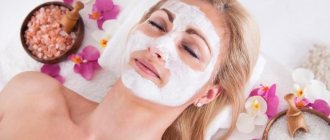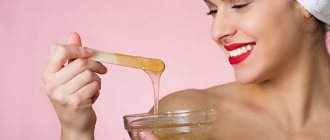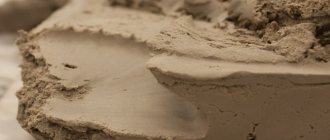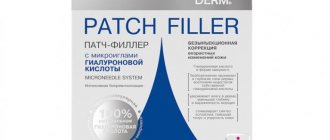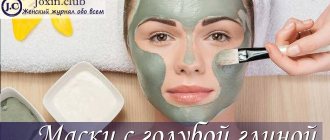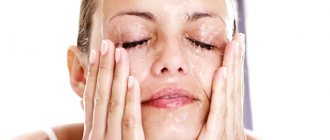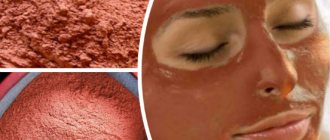Today, clay is in demand not only for construction purposes.
Thus, in cosmetology, this substance is often the main component underlying masks and compresses. Thanks to the mineral composition, the condition of the skin and hair improves, their appearance becomes more well-groomed and healthy. It is very easy to purchase cosmetic powder - in a pharmacy or the household goods department of a supermarket. It has a relatively low pricing policy - from 30 to 60 rubles for a small bag, but ready-made masks will cost more. Cosmetic clay is able to remove toxins from the skin, saturating it with useful minerals - phosphorus, iodine, potassium, magnesium, sulfur, zinc, nitrogen, manganese and calcium. With proper calculation of proportions, application, and storage, clay-based face masks do not pose any risks to the health of the skin and the entire body. The only exceptions are isolated diseases, as well as individual intolerance to the components included in its composition.
Properties and effect on the skin
Using clay significantly improves the condition of the outer layer of skin. The main advantage of this element is to cleanse and dry the epidermis. Masks prepared on its basis regulate excessive sebaceous and sweat secretions, remove impurities from pores, even out and refresh the complexion. In addition, the skin becomes more elastic and tightened.
Another benefit of clay is its exfoliating, anti-inflammatory, antibacterial and analgesic effects. During its use, an environment is created at the site of the lesion that is inconvenient for the life and development of pathogenic bacteria. Mineral substances suppress their development, which is especially important when purulent abscesses and ulcers occur. Clay relieves inflammation and soothes, so its use is recommended for sprains, burns and bruises. Masks made from this component also relieve itching and avoid irritation in sensitive areas.
To make the result more effective, it is necessary to dilute the clay masses with other natural ingredients: essential and cosmetic oils, herbs or decoctions prepared on their basis, chicken and quail eggs, fruits, berries, sour cream, gelatin.
Useful properties of white clay
The properties and benefits of white clay for the face are especially well known. Kaolin:
- regulates collagen production and rejuvenates the skin;
- helps cope with inflammation and eliminates bacteria;
- has a scrubbing effect and smoothes the skin;
- improves complexion and eliminates bruises and bruises;
- accelerates blood circulation and removes swelling;
- dries out too oily skin;
- helps get rid of cellulite in problem areas of the body.
White clay can be used not only to combat existing problems. Kaolin is an excellent remedy for prevention.
The properties of white clay for internal use are useful - kaolin helps with intestinal and stomach ailments, eliminates heartburn and cleanses the body of harmful substances.
Types of cosmetic clay
By nature, there are two types of clay: bentonite and kaolin. The latter, in turn, is divided into several types. This can be judged based on the color of the substance. Its mineral composition and, consequently, its color will depend on the place of birth.
All types of kaolin clay have not only their own color. Each of them has its own individual properties, due to which they are used for different purposes. Read about the best clay face masks in this article.
Clay is a natural component obtained naturally as a result of the destruction of rocks under the influence of various natural phenomena.
White
White is considered the most sought after and delicate among other species. Its versatility allows it to be used for any skin type. It brightens, cleanses pores, helps fight pimples and acne, and also eliminates oily shine.
Blue
Blue is used for normal and combination skin. Silver, which is part of this species and colors it in a characteristic shade, has an antiseptic and anti-inflammatory effect. The drug nourishes, tones, soothes, and also effectively fights pigmentation caused by skin aging.
Green
A mask made from this mineral is suitable for any skin type. It tones, nourishes, moisturizes, relieves puffiness and oily shine. It is this substance that contains aluminum and silicon dioxide, which promotes the speedy healing of wounds, as well as the treatment of certain skin diseases - eczema, acne and dark spots. Green clay is recommended for the care of both young and aging skin of the face and body.
Red
A mask made from red clay has a tightening effect, which is especially important for dull and aging skin. Thanks to its use, the blood circulation process is accelerated and the skin tissue is saturated with oxygen. Recommended for sensitive types in winter.
Pink
Pink clay is recommended for the care of any skin type. The balanced composition of mineral salts, iron oxide and silica contained in pink clay cleanses the epidermis of toxic substances, removes fat, relieves dryness and irritation, improves blood circulation, tightens the facial contour and smoothes the skin from wrinkles.
Yellow
The large amount of potassium and iron present in this clay improves oxygen supply to the skin of the face and neck. A mask based on yellow clay helps eliminate harmful toxins, reduces inflammation and tones the skin. Recommended for aging and oily skin.
Black
Black clay contains beneficial minerals and trace elements, recommended for oily, combination and normal skin types. Removes shine, stimulates lymphatic drainage and reduces puffiness. A drug with such a mineral composition absorbs harmful toxins well, cleanses the skin of impurities, tightens pores and fights blackheads.
Gray
Gray clay-based masks have anti-inflammatory, moisturizing and toning effects. Recommended for caring for problematic and dry skin. It has a rejuvenating effect and has a healing effect on boils.
Blue
This substance has a whitening, softening and cleansing effect. It has the ability to tighten pores and accelerate the process of cell regeneration, thereby providing a rejuvenating effect. Blue is suitable for all skin types and all ages.
General Product Information
Clay used in cosmetology is rich in minerals and trace elements that have a beneficial effect on human skin. To understand what clay consists of, you need to carefully study the instructions for its use. Typically the product contains:
- iron;
- manganese;
- sulfur;
- iodine;
- potassium;
- phosphorus;
- magnesium.
Each type of substance has its own deposit. Anapa white clay is extracted from sea sources. Moroccan is a mixture of lake origin, located in layers in a mountain valley, near the city of Fes. The Valdai Blue lies deep in the Valdai Upland and is distinguished by its glacial origin. Black tea is mined from the bottom of the Dead Sea, so it contains a lot of sulfur, which is necessary for the treatment of hair and nails.
How to choose
Skin care for the face and neck requires an individual approach. Therefore, you need to choose a product based on the problems that concern the owner of a particular type of epidermis. Knowing the healing properties of each type of clay, you can make the right choice. To choose a cosmetic powder, you need to know your skin type. Dry, oily, normal and combination skin need their own separate components to improve its structure. A consultation with a cosmetologist will help you determine your skin type and choose the right clay to apply at home. Read about which clay to choose for your face here.
Why use clay for your face?
Cosmetic clay is an environmentally friendly product, so its use in cosmetology is invaluable.
Affordability and ease of use are considered serious arguments in its favor. This beauty product opens up a lot of possibilities for skin care: it can absorb and retain moisture; herbal decoctions, essential oils, fruit, vegetable, berry purees and eggs are added to clay-based masks to enhance a certain effect.
The mineral product is used in the preparation of medicinal baths, in the improvement of weakened hair, and in bandages to eliminate bruises and other cosmetic defects.
This natural remedy can deeply cleanse the skin, giving it elasticity and firmness, restore cells and heal the dermis, and also remove toxins from the skin.
Did you know?
Clay is a natural antiseptic. There are no bacteria in it.
How to make masks
The traditional way to prepare a face mask at home is to combine purified water or herbal decoction, as well as the clay powder itself: 2 tbsp. l. liquid component per 3 tbsp. l. clay. As soon as the liquid is well absorbed into the powder, the base is mixed until smooth so that there are no lumps left.
Method of preparing, applying and washing off a clay mask.
Otherwise, applying the product will not give the desired effect. The structure of the prepared mass should be similar to thick sour cream.
Clay loves light, so before applying a mask based on it, you should leave it in the sun or under a daylight lamp.
Mixing is carried out only with a wooden spatula or spoon. The homemade mask is left on for 40-60 minutes. in a warm place, then add a little essential oil. Its quantity will depend on the purpose of use. For oily skin, fruit or vegetable juices are used instead of water, and lemon and lavender essential oils are added. For dry and normal skin, honey, milk, olive oil and egg yolks are perfect.
White clay for cellulite
One of the most useful properties of white clay is that the product effectively helps remove the unsightly lumpiness of cellulite on the body. White clay draws out toxins and waste from the epidermis, eliminating their harm, removes excess fluids and salts, relieves swelling and increases the elasticity of the skin.
To combat “orange peel”, white clay wraps are mainly used. The procedure can be carried out using white clay alone, or you can mix kaolin with honey, cream, cinnamon or essential oils, which will provide additional benefits.
For example, a remedy made from 3 large spoons of clay, 1 spoon of cream and 1 spoon of honey is beneficial. The mixture is distributed over the previously cleaned body in problem areas, the treated areas are wrapped in cling film and placed under a warm blanket for 40 minutes. After the expiration date, the clay is washed off with water. It is best to repeat healing wraps every other day, then by about the 10th session the beneficial properties of the procedure will have an obvious effect.
Important! To eliminate cellulite, baths with the addition of white clay and massage are beneficial.
It is especially useful to combine and alternate all 3 procedures; there will be no harm from this.
Rules and frequency of use
Face masks are used no more than twice a week. Apply only to clean skin, spread in a thin layer and leave for an average of 10-15 minutes. For the treatment of skin diseases, the action time is increased to 2 hours. In this case, the resulting mass is first applied to gauze or a napkin and only to the affected area.
Wash off with cool water or a contrast shower. Next, the face is lubricated with moisturizer. Using a mask made from any type of clay allows you to preserve the beauty and elasticity of the skin, prolonging its youth. For greater efficiency, different types of clay can be mixed.
Since mineral powder has a drying property, for oily skin its use should not exceed 20 minutes. With the dry type, the time is reduced to 7-10 minutes, and with the normal and combined type - no more than 15.
Read about using a clay mask for acne in this material.
The prepared clay mask can be stored in the refrigerator for 2-3 days in a closed ceramic or plastic container. To get the maximum effect from applying clay, you need to make a new portion for each procedure. The session itself is carried out in the bathroom at high humidity, preferably in a lying position. If applying the mask is done in the room, from time to time it must be moistened with water by spraying it on the face from a spray bottle. Otherwise, it will dry out and tearing it away from the skin will damage the epithelium.
Read about the L'Oreal Magic Clay face mask at the link.
Before using the mask, you should not wear makeup for 10-12 hours. This method increases the healing and cosmetic effect of clay and protects pores from contamination. After the mask, you need to choose a moisturizer that can preserve the natural moisture of your facial skin.
Clay is used not only in cosmetology, but also in medicine for oral administration. The elements in its composition treat anemia, as well as diseases of the stomach and intestines.
Clay mask recipes
After applying the clay mask, you need to lie down and completely relax. At the same time, it is forbidden to strain muscles and use facial expressions to avoid the appearance of new wrinkles.
For problematic epidermis
- Cleanses and evens out complexion
Add 3 drops of apple cider vinegar and a little water to a tablespoon of blue clay until the consistency of sour cream appears. When applying to the face, pay special attention to areas with acne and comedones.
- Tonic
Combine blue powdered clay with watermelon and grape pulp until a thick paste is formed. You can add a little low-fat sour cream to the mixture. Mix all the components of the mask and apply an even layer to the skin.
For normal and combination epidermis
- Combine green and white clay powder (a teaspoon each). Add a teaspoon of peach oil to them and dilute the mixture with mineral water until a thick mass is obtained.
For fading epidermis
- Boil 1 raw cabbage leaf in ¼ cup milk or cream (if your skin is very dry) until softened. Then grind the mass in a blender, cool, add a tablespoon of green clay and ½ raw quail egg yolk. The composition must be mixed very thoroughly before applying to the skin.
For sensitive skin prone to irritation
- Dilute the red clay with warm milk to a thick consistency and apply to the skin along the main lines.
- Dissolve ½ part of a tablespoon of red powdered clay in warm heavy cream (in a tablespoon), add the same volume of aloe juice to the mass, stir well and apply the mass to the face.
Contraindications
Home clay procedures may have contraindications for use. You should not make clay masks if you have diseases of the circulatory system or if there is an exacerbation of individual chronic diseases. Any cosmetic mixture made from clay can cause allergic reactions. Most often, they appear not from the clay itself, but from some components of the mask. It should not be used for chronic skin diseases. First, a test smear of clay is made on the inner bend of the elbow and the reaction is observed. If there is redness and burning, you should stop using the mask for a while.
Before using a clay mask, you must perform an allergy test. To do this, apply a small amount of clay to the inside of the forearm and wait a few hours; if itching and burning does not occur, then you can apply the mask to the face.
Clay masks are prohibited for women during pregnancy and during the menstrual cycle. Pure clay is contraindicated for women with aging skin of any type, since after its use the level of moisture in the skin decreases to a critical level.
How to take white clay internally
Kaolin has not only cosmetic, but also medicinal properties. The benefits of white clay internally are manifested in the treatment of heartburn and gastritis; kaolin relieves symptoms of poisoning and eliminates parasites. But to avoid harm, clay must be used according to strict rules.
- A large spoonful of white powder is diluted in a glass of water. You do not need to drink the clay right away - first, leave the glass for several hours until the kaolin settles to the bottom. A certain amount of useful particles will dissolve in the water itself, and the properties of such a liquid will be beneficial when taken internally.
- The benefits of edible white clay will be if you drink no more than a glass of clay infusion per day. In total, treatment should last 3-4 weeks, in case of serious illnesses - up to 6 weeks. If used for too long, harm may occur.
- At the same time as drinking the infusion, you need to drink a lot - at least 2.5 liters of clean water per day, so that the kaolin does not cause harm.
Advice! The benefits of white clay for the body will appear if you dilute it in water, juice or tea, but you should not use milk for the drink.
Results
- The mask is a kind of peeling, helps normalize the functioning of the sebaceous glands, nourishes and moisturizes, disinfects, gives the skin firmness and elasticity, heals the dermis and deeply cleanses the pores.
- Each type of clay has its own individual properties, so their use is possible for any skin type.
- Mixing different types of mineral enhances their effect.
- Clay itself has no contraindications and is therefore safe for use.
- You can use masks at any time of the year, but they are especially effective in summer and winter, when the level of stress on the skin from ultraviolet radiation or cold is quite high.
A high-quality homemade clay mask requires adherence to exact proportions, as well as proper application to the skin and storage conditions. Read about recipes on how to make a clay mask at home here.
Some tips
- Most clays have a drying property, so in their pure form they are ideal for oily and combination skin.
- For normal and dry skin, it is better to use clay in masks, mixed with other ingredients (egg yolk, honey, dairy products, oils, etc.).
- To avoid the feeling of skin tightening, do not keep the clay mask on your face for more than 15 minutes. After using the clay mask, it is recommended to apply a nourishing cream to the skin.
- Based on clays, you can prepare any nourishing masks, such as fruit masks. In addition to its beneficial properties, clay also gives masks a pleasant consistency.
- Clay masks are not recommended to be used more than 3 times a week for oily skin and more than 1 time a week for dry skin.
- An excellent effect is achieved by adding essential oils to the clay (selected depending on the tasks and skin type).
- Clay can also be used as a light peeling when washing for daily skin care.
doclvs.ru
Attention!
The information on the site does not constitute a medical diagnosis or a guide to action and
is intended for informational purposes only.
